A fossil free internet is an internet that has transitioned away from burning fossil fuels as its primary source of electricity and towards renewable sources in its place. In this piece, Chris Adams of the Green Web Foundation outlines why we need a fossil-free internet by 2030 and how to get there.
If you were to look at the last 240-odd years since the industrial revolution, one of the key stories often told is one of improved quality of life, largely through increased access to useful energy. If we were to look a little more closely, we might see that this rate of improvement has varied pretty wildly depending on where you are in the world, but by and large, where there has been this improvement, the extra energy has largely come from burning fossil fuels.
Burning these fuels has given us the energy to help in lots of ways—we use it to move around quickly, stay warm, and in the case we’re discussing here, to generate electricity to access the internet. Even in 2021, we still rely on fossil fuels for about two-thirds of our electricity.
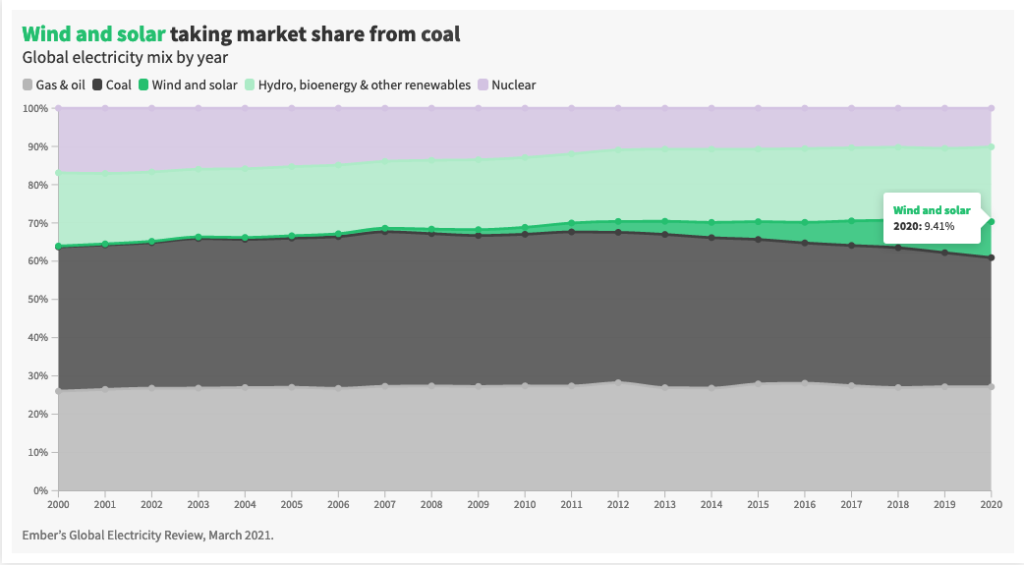
However, it’s not the only way we can get energy these days. The sliver of darker green you see in this chart has been the growth in wind and solar globally. It’s definitely coming from a small base when you look at those ominous bands of grey representing gas, oil and coal, but if the pandemic has taught us anything, it’s how powerful exponential growth can be, and how quickly it can sneak up on you. Renewables, particularly wind and solar, are growing exponentially.
But why are they growing exponentially, and what does this have to do with the internet?
We’ll get to that, but first, let’s take a moment to talk about why you might want a fossil free internet from an equity and justice point of view first.
Even if it cost exactly the same amount to power an energy system (and by extension, the entire internet) on fossil fuels as it did to power it on renewables, it would make sense to use renewables if you could, and for a number of reasons.
Fairer access to energy
Access to renewable energy is much more equitably distributed than energy in the form of fossil fuels. Let’s take the story of solar. The sunniest place in the world Azerbaijan is only four times sunnier than the cloudiest place in the world, Norway. Contrast this with how oil is distributed, you’ll see that the places with the most oil have a million times as much as the places with the least.
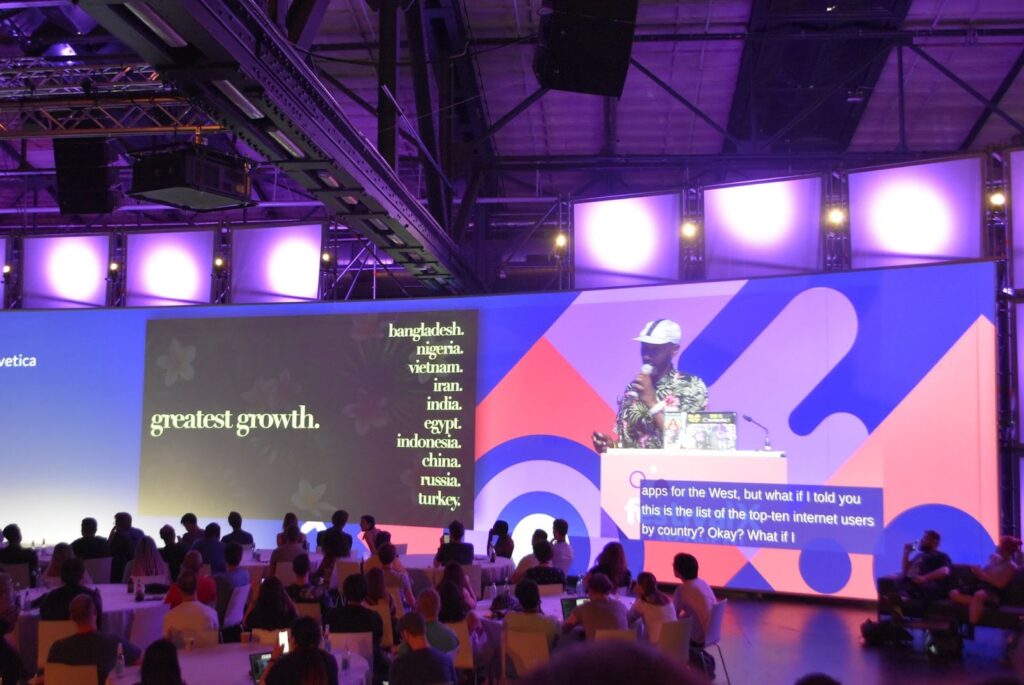
Also, if you look where “the next billion users” to join the internet will be coming from, almost all will be coming from places outside North America and Europe. These are places that tend to be blessed with more sunshine than average but in many cases end up paying for expensive imports of fossil fuels to power their economies.
Even when you take into account the sourcing of the minerals you would need for an energy transition to safer, cleaner forms of energy, the differences are less pronounced than the current situation we have with fossil fuels.
Also once you have a way to generate energy, you don’t have to keep buying fuel from someone. Owning your own (literal) means of production is a pretty good way to build power and disrupt chains of dependency that have existed for decades.
Owning your own (literal) means of production is a pretty good way to build power and disrupt chains of dependency that have existed for decades.
Moore’s Law, Wright’s Law, and the magic of experience curves
If you work with computers, you might have heard of a phenomenon known as Moore’s Law, named after the co-founder of Intel. Since the 1970s’ it’s been the oft-cited law that every two years, the number of transistors you can fit on a circuit doubles. This translates to computers getting inexorably cheaper and more powerful with each year.
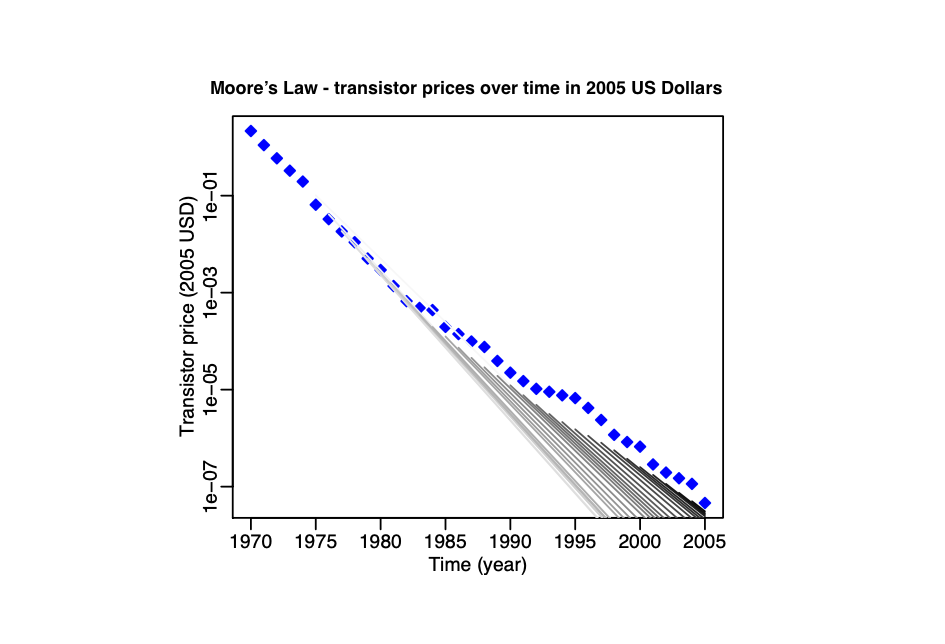
However, Moore’s Law does not mean computers magically get cheaper all by themselves – they’ve been getting cheaper because as we’ve made more of them, we’ve got better at making them.
This premise, that the cost changes based on how much we do something, not how long we have been doing it, ends up being a better way to predict how costs change over time. It also has it’s own name and creator.
In the 1930s, the costs of building aircraft fell dramatically as we learned to build them at scale. For every doubling in production volume, the cost per plane would come down by about 20%. After the engineer, Theodore P. Wright published a paper about this phenomenon, “Factors affecting the costs of aeroplanes”, it became known as Wright’s Law.
This drop in cost as production scales is sometimes also known as the learning rate – it represents how quickly we get better at building things with experience. And crucially, it compounds over time.
If you made a chart it might look a bit like the curve below. Because these often look like curves, it’s common to refer to them as experience curves.
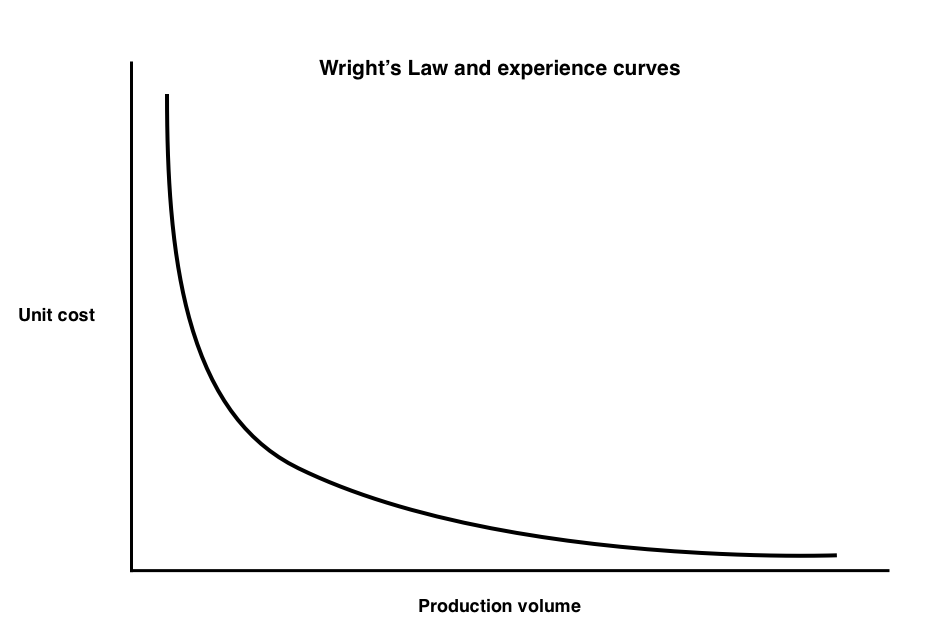
Wright’s Law is close to a hundred years old now, and as a result we have decades of data to we can test it against. It turns out that it applies to a wide range of different technologies, but not all technologies.
And if you look at the excitingly titled paper Empirically grounded technology forecasts and the energy transition from the Oxford Institute for New Economic Thinking, we can see some of this helpfully charted for us.
Let’s look at the historical data for fossil fuels.

Even as fossil fuel use has increased massively over the last 140 years, we’ve seen no real evidence of learning rates – and once you take inflation into account, you’d see that fossil fuel prices have largely stayed the same.
For folks on lower incomes, it can be difficult to afford the ongoing costs of fuel, and to compensate, we’ve ended up with many well-meaning policies globally, intended to make sure people have access to energy – largely by subsidies to make them seem cheaper to those buying them.
The result? Globally, we now subsidise fossil fuels to the tune of around 6 trillion US dollars every year.
Globally, we now subsidise fossil fuels to the tune of around 6 trillion US dollars every year.
But it’s not the only way to get cheaper energy.
Changing the defaults from ones that don’t learn, to ones that do learn
We’ve seen that with fossil fuels, you do not really have much of a learning rate. But we can see that some technologies like wind, solar, batteries, and now hydrogen electrolysers definitely do. As an example, the cost of solar panels is 1000 times lower than it was in the 1960s. And both batteries and solar in 2021 are about 10 times cheaper than they were just 10 years earlier.
What’s more, recent studies of learning rates across different technologies show that once we have enough data to see if there is a learning rate, it’s persistent. The technology keeps getting cheaper as production keeps increasing, up until it has become the dominant technology and then production tails off.
Again, if we borrow another chart from our new friend Empirically grounded technology forecasts and the energy transition, we can see the prices trending downwards spectacularly.
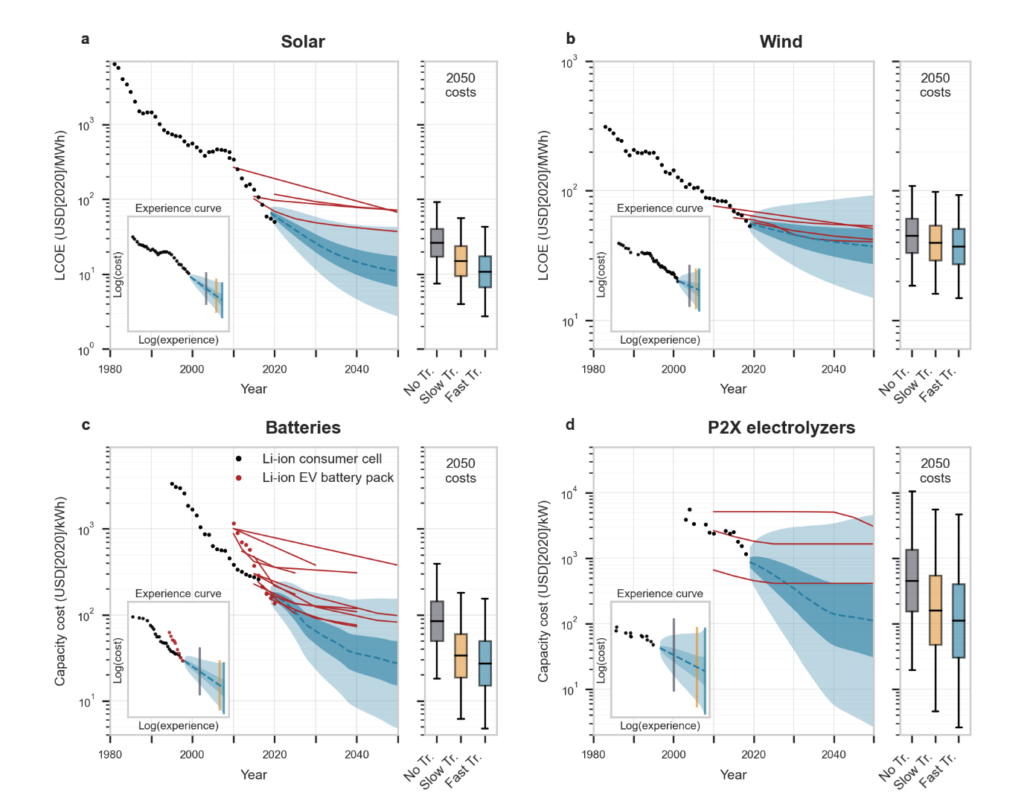
If you follow these experience curves through to 2030 and beyond, for solar, wind, batteries and electrolysers, you end up with energy being so cheap, that the most expensive energy in 2030 would be the same price as the cheapest energy in 2020.
At these costs, even if fossil fuels didn’t cause millions of unnecessary deaths, and accelerate climate change, it would make no sense to use them, as they’d be dirtier, and more expensive than the new default of renewables.
At these costs, even if fossil fuels didn’t cause millions of unnecessary deaths, and accelerate climate change, it would make no sense to use them, as they’d be dirtier, more expensive than the new default of renewables.
This means that while we can’t change the physics around climate change, we can change the economics around climate change if we’re thoughtful about where our energy comes from.
Instead of artificially subsidising fossil fuels to make them seem cheap and accessible, we could choose to spend the same money on scaling up safer, better performing renewable technologies instead. We’d make energy more accessible in the short term, and by doing so, we’d also be bringing down the cost of energy for everyone, permanently.
The dream of a fossil free internet.
What does this have to do with the internet? At the Green Web Foundation, we talk about a fossil-free internet for a few reasons.
We know that the internet has a sizable energy footprint, and we know that this electricity has to come from somewhere— right now the default is fossil fuels. We also know that some technologies get cheaper the more you invest in them… and that some don’t.
Globally, some sectors are difficult to decarbonise, like aviation. Yet some like the IT sector, are comparatively easy. Focusing efforts there to begin with will make it easier to decarbonise others later because displacing fossils would involve scaling up renewable energy in its place – which we now know would make it cheaper and more accessible everywhere else.
Changes here are what you might call first-tonne emission reductions. If you do them first, they have a compounding effect that helps in all the other areas. A lot of the time, they’re also cheaper than business as usual over the medium to long term.
We think this is a better approach than just keeping the internet as it is, and just doing something like planting trees, or even relying on carbon removal to offset the emissions from electricity. You might call these last tonne emission reductions, and they’re better off used for things where we don’t really have any mainstream alternative options yet.
Getting to a fossil free internet from here
If a fossil-free internet sounds like a good thing to you, it’s important to understand that many of the routes there involve systemic changes, and engaging as a citizen over engaging as a consumer. But there are still some things you could do tomorrow.
If you use digital services as a customer, then you can simply ask the providers of services if they have plans about greening the way they build them. It helps people inside the companies make the case for doing the right thing, and for playing a part in the transition of the internet away from fossil fuels. We have a free website checker you can use, and it’s used in a number of sites you might have heard of like Website Carbon.
If you build digital services and you want to account for emissions from computers, then instead of buying offsets, think about spending the same money on deploying renewables in your part of the world. Companies like Clearloop in the US, and Ripple Energy in the UK help with this. They allow you to help finance the rollout of wind and solar that otherwise wouldn’t be built.
If you run infrastructure yourself or if you run datacentres, it’s likely that companies like Google pay less than you do for power. This is because they use enough electricity to be able to arrange power purchase agreements, which are deals to buy the power from a renewable energy project over a multi-year period that helps it get built. The reward for this commitment is a supply of fossil-free energy at stable, low prices. Companies like Zeigo are working to make these accessible to smaller organisations, but in Europe groups like the Sustainable Digital Infrastructure Alliance work at a policy level too.
Branch magazine was written for people who dream of a sustainable internet. A fossil free internet by 2030 isn’t a dream: it’s a goal within reach, one that we can and should strive for.
You can read more about getting to a fossil-free internet on the Green Web Foundation website.
AUTHORS
Chris Adams is a co-organiser of the online community Climate Action.tech, and a director of the Green Web Foundation, leading their energy, open source and open data initiatives.
